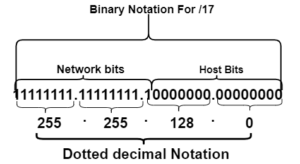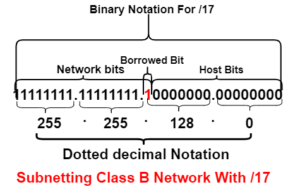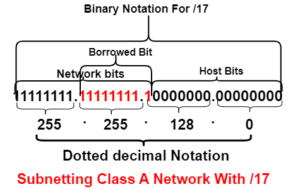The /17 subnet mask is a subnet mask with a dotted decimal notation of 255.255.128.0 and a wildcard mask of 0.0.127.255.
/17 subnet mask divides a large network into a smaller network (subnetworks). Each of the subnetworks has a range of 32768 IP addresses. The first IP in this range is the network ID, and the last IP in this range is the broadcast IP address. Therefore, there are 32766 usable IP addresses in the /17 subnet mask.
Subnetting with a /17 Subnet Mask (Example)
Let’s consider subnetting the network 192.168.0.0/16 (a class B network) with a /17 subnet mask. It will yield just two subnets; the first subnet will contain a range of 32,768 IP addresses (including the network ID and the broadcast ID), and the second subnet will contain a range of 32768 IP addresses.
First Subnet:
- Network Address: 192.168.0.0
- Usable IP Range: 192.168.0.1 to 192.168.127.254
- Broadcast IP Address: 192.168.127.255
Second Subnet:
- Network Address: 192.168.128.0
- Usable IP Range: 192.168.128.1 to 192.168.255.254
- Broadcast IP Address: 192.168.255.255
/17 Subnet Mask IP range
For a /17 subnet mask, there is a range of 32768 IP addresses. The first IP address in this range serves as the network ID, and the last IP address functions as the broadcast IP address. Hence, there are precisely 32766 usable IP addresses in a /17 subnet mask.
/17 Subnet Mask Dotted Decimal Notation
For a /17 subnet mask, the dotted decimal notation is 255.255.128.0. This is obtained by setting the first 17 bits of the 32-bit IPv4 address to 1s, setting the remaining 15 bits to 0s, and then converting from binary to decimal.

Subnetting Class B Network with /17 Subnet Mask
To subnet a class B network with a /17 subnet mask, we need to borrow 1 bit from the host bits, resulting in the binary representation; 11111111.11111111.10000000.00000000. Remember, the original binary representation for the class B subnet mask is 111111111.11111111.00000000.00000000.

Number of Subnets
The formula for calculating the number of subnets remains 2^(number of borrowed bits). In this case, it yields 2^1 = 2 subnets.
However, adhering to RFC guidelines, two subnets are reserved for specific functions. Therefore, the usable number of subnets is 2 minus 2, resulting in 0 usable subnets.
In practical terms, subnetting a class B network with a /17 subnet mask wouldn’t leave any usable subnets available due to the reserved subnets for specific functions according to RFC guidelines.
Subnetting Class A Network with /17 Subnet Mask
To subnet a class A network, which has a binary representation of 11111111.00000000.00000000.00000000 with a /17 subnet mask, 9 bits are borrowed from the host bits and added to the network bits. This results in the binary representation 11111111.11111111.10000000.00000000.

Number of Subnets
The formula for calculating the number of subnets is 2^(number of borrowed bits). In this case, it results in 2^9 = 512 subnets.
However, according to RFC guidelines, two subnets are reserved for specific functions. Therefore, the usable number of subnets becomes 512 minus 2, resulting in 510 usable subnets.

I am a passionate Networking Associate specializing in Telecommunications.
With a degree in Electronic engineering, I possess a strong understanding of electronic systems and the intricacies of telecommunications networks. I gained practical experience and valuable insights working for a prominent telecommunications company.
Additionally, I hold certifications in networking, which have solidified my expertise in network architecture, protocols, and optimization.
Through my writing skills, I aim to provide accurate and valuable knowledge in the networking field.
Connect with me on social media using the links below for more insights.
You can contact me using [email protected] or connect with me using any of the social media account linked below



